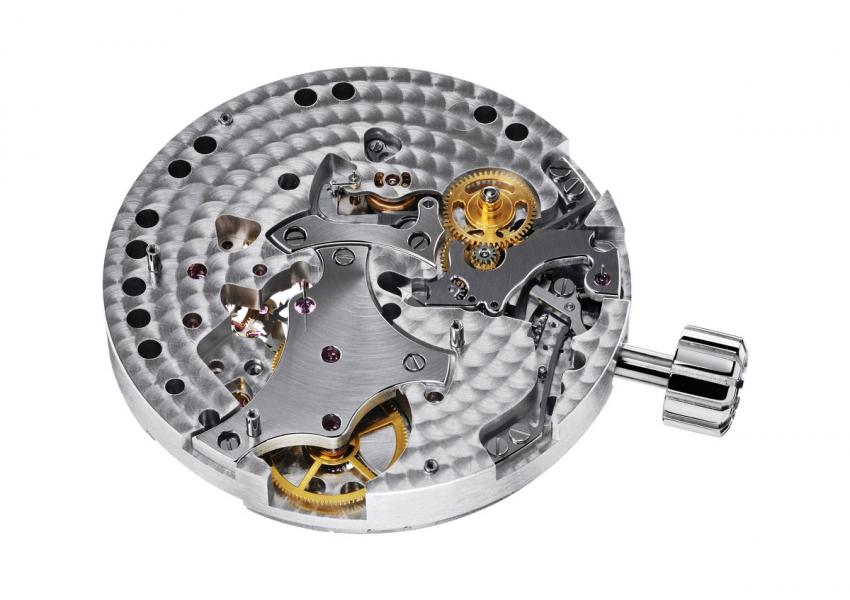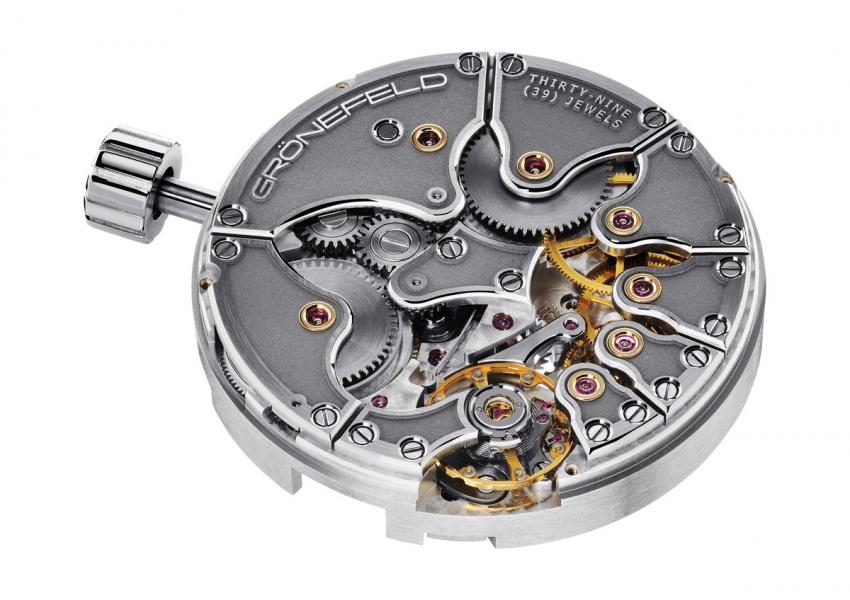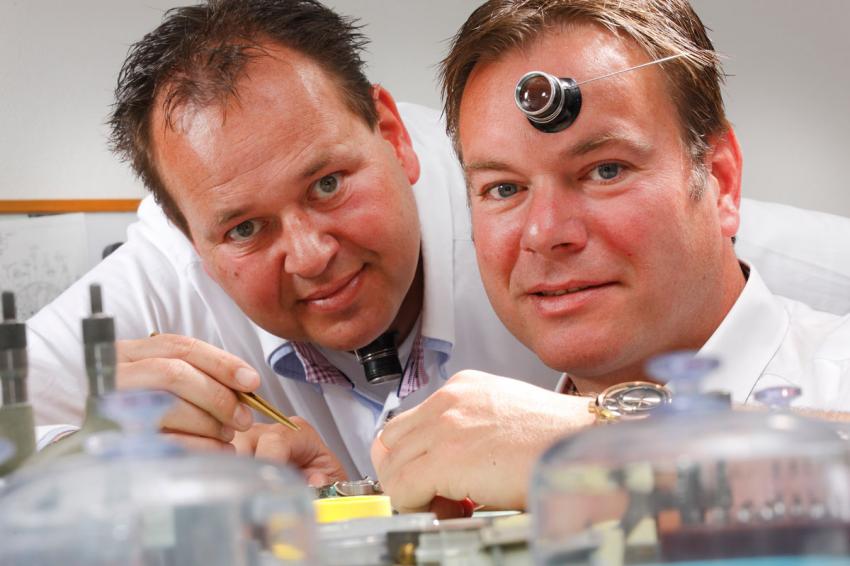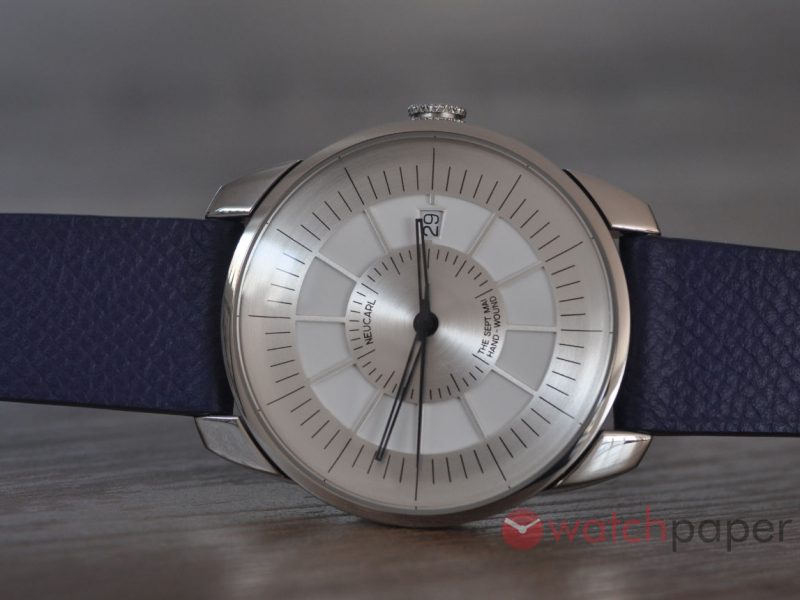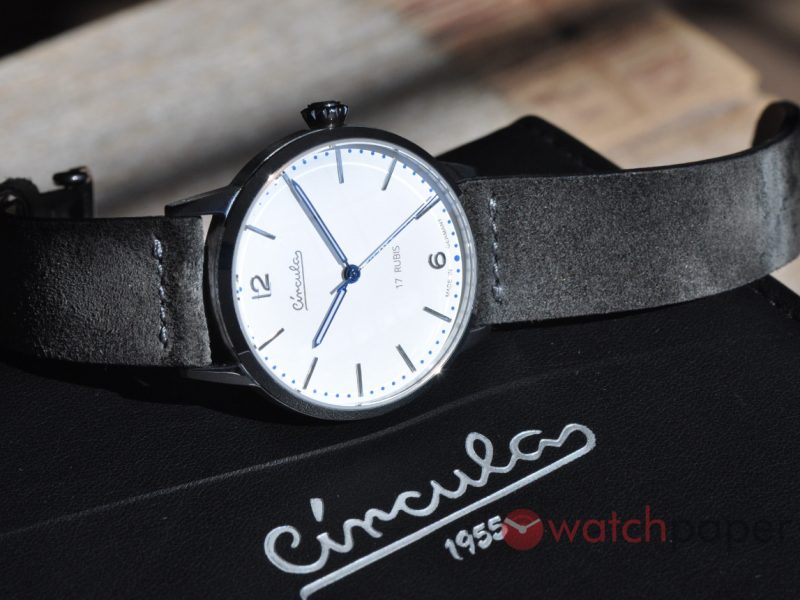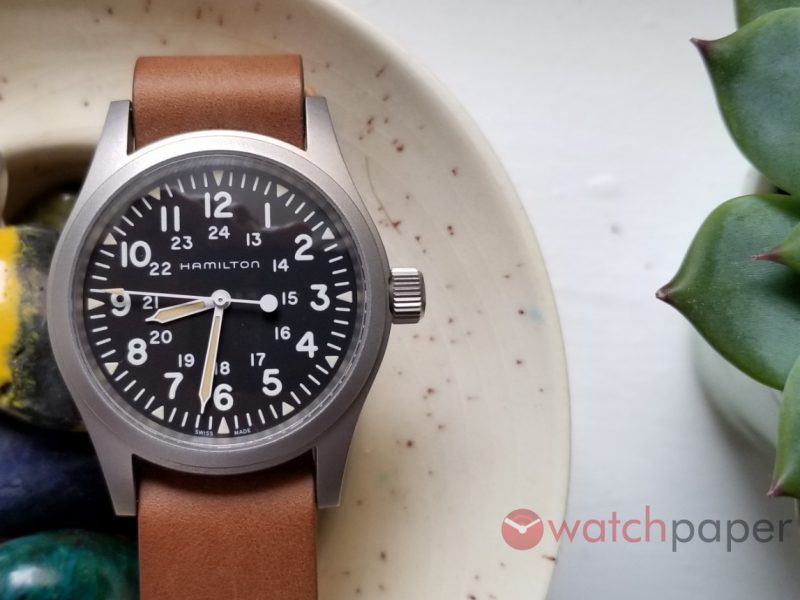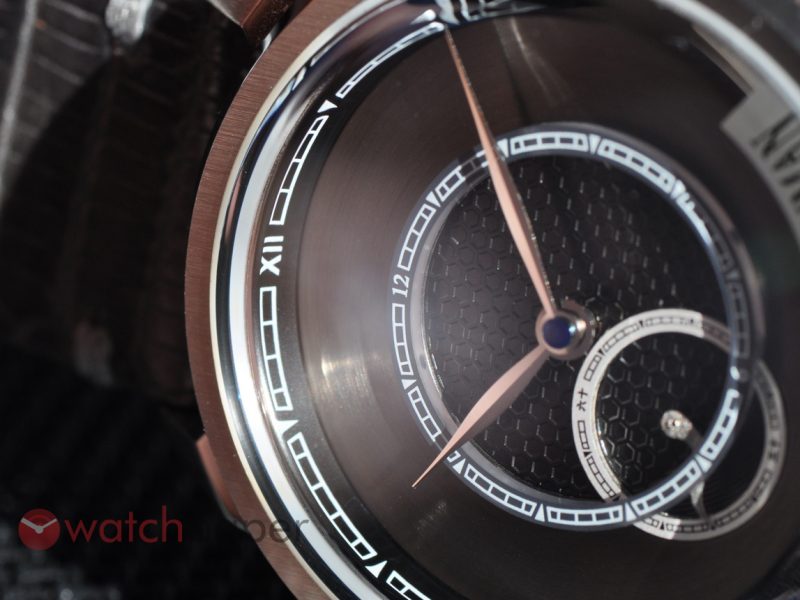Grönefeld One Hertz — The world’s first and only series wristwatch with independent dead seconds
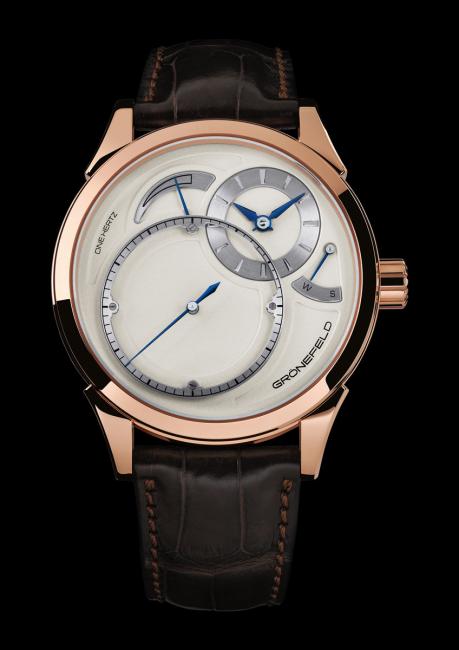
The Grönefeld One Hertz: red gold case, solid silver dial displaying hours and minutes, independent dead seconds, power reserve indicator and Winding-Setting indicator.
The Grönefeld One Hertz is the world’s first and only series wristwatch with independent dead seconds. It features a beautiful solid silver dial and entirely in-house developed movement with stainless steel bridges and exceptional fine finishing.
With dead seconds – secondes mortes in French – the seconds hand advances in full steps of one second instead of the usual smooth sweeping action of mechanical seconds. Dead seconds was a very respected mechanical complication because it denoted superlative accuracy. However, the popularity of dead seconds faded in the 1970s and 80s with the dominance of quartz movements, which also stepped in full seconds. Mechanical movements soon became distinguished by a smooth, sweeping seconds hand.
The Grönefeld One Hertz is unique among wristwatches in that its dead seconds are powered by a secondary gear train, which is completely independent of the gear train for the hour and minute indications. Until the arrival of the One Hertz, dead seconds was usually derived from mechanisms requiring considerable force from the going train. This resulted in more wear and less energy available to the escapement.
The large seconds hand of the One Hertz subtly signals its unique mechanism, imperceptible to most, but obvious to haute horlogerie connoisseurs who will appreciate the flawless hand-finishing of all 285 components of the calibre G-02, Grönefeld’s own proprietary movement.
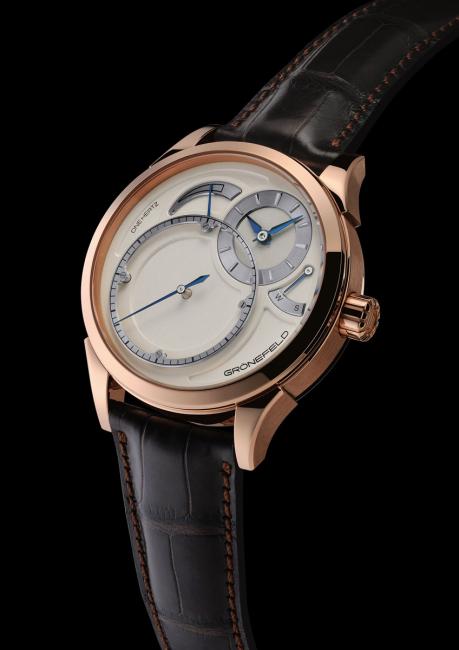
With the One Hertz, Bart and Tim Grönefeld have resurrected the long-neglected horological complication of dead seconds.
While the dial is dominated by the over-sized dead seconds, elegantly shaped blued-steel hour and minute hands make for easy reading of the time in the sub dial at 2 o’clock. The hour/minute sub dial is nicely balanced on either side by a power reserve indicator at 11 o’clock and a winding-setting (W-S) function indicator at 3 o’clock. Winding and setting are selected by pushing the crown in, instead of pulling it out – a very ergonomic system – and the winding-setting indicator provides a neat visual signal of the mode selected. What’s more, the counter-poised seconds hand ‘hacks’ – i.e. stops – when ‘setting’ is selected, to enable maximum precision when setting the time.
The dial is crafted out of solid sterling silver then blasted with brass particles to attain a frosted finish with a very slight sparkle. A thin layer of transparent lacquer is then applied to prevent tarnishing. The soft sheen contrasts superbly with the flamed-blued hands, making for excellent legibility. The graceful arcs and curves of the displays are complemented by the three-dimensionality of the multi-layered dial. The ensemble is beautifully framed by the highly-polished red gold case and bezel.
All applied dial elements, including the dead seconds chapter ring, are rhodium plated with circular graining and beveled edges. The bevels are polished with diamond paste to a brilliant gloss, creating scintillating reflections of light echoing the high-end finishing of the stainless steel movement bridges visible through the display back.
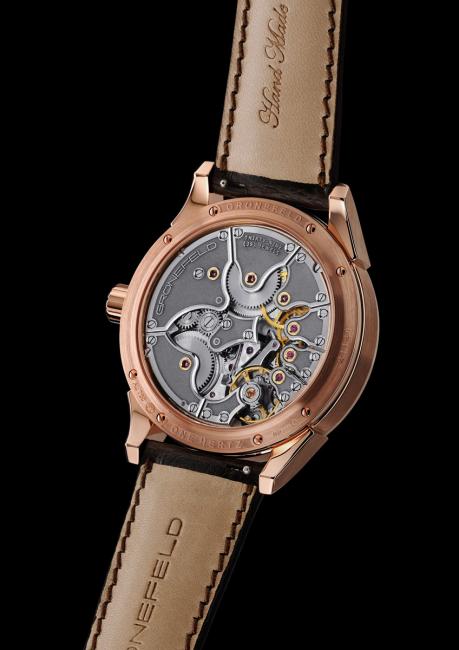
Through the back we can admire the in-house Calibre G-02: 285 components, 39 jewels, 72 hours of power reserve, hand bevelled bridges are just some of the features that make this movement exceptional.
While pocket watches have featured independent dead seconds in the past, the Grönefeld One Hertz was the first series wristwatch to feature independent dead seconds. The Grönefeld One Hertz is unique among wristwatches in that its dead seconds are powered by a secondary gear train, independent of the gear train for the hour and minute indications.
Mechanical wristwatch movements often have balance frequencies of 2.5 to 5 hertz, which results in the seconds hand making tiny steps of 5 to 10 steps each second and looking like a smooth movement. The seconds hand of the One Hertz is either stationary (dead) or jumping in a full one-second increment each second.
In a dead seconds complication, friction of the mechanism has to be absolutely minimal so it does not interfere with the escapement and timing. For the One Hertz, Bart and Tim Grönefeld developed an independent dead seconds mechanism that is driven from its own secondary gear train with its own independent power supply. The dead seconds are driven from one mainspring barrel and the hours and minutes from another. With virtually no adverse influence on the escapement this low-friction system lends itself to a highly-precise timing rate.
The two mainspring barrels are wound simultaneously from the crown, which features an innovative “push to set”, “push to wind function”, with the mode selected indicated at 3 o’clock. A power reserve indicator at the top of the dead seconds dial keeps track of the 72 hours of autonomy.
Technical Specifications
The One Hertz RG is available in a 43mm 5N red gold case.
Features and indications
Independent dead seconds – large dial at 7 o’clock
Hour and minutes – subdial at 2 o’clock
Power reserve indicator at 12 o’clock of seconds ring
Innovative Winding-Setting mechanism Winding-Setting indicator at 3 o’clock
Solid silver dial
In-house calibre G-02
Case and dial
Case: 5N red gold case; sapphire crystal on the front is slightly domed with anti-reflective treatment on both sides; sapphire crystal on the back is flat with anti-reflection treatment on the inside; engraving of serial number and model; 8 security screws
Number of case components: 68
Case dimensions: Diameter: 43 mm; thickness: 12.5 mm
Water resistance: 3atm/30 meters/100 feet
Crown: Engraved with “G” logo and push to set/wind function
Dial: in solid silver
Seconds chapter ring: Rhodium plated with circular graining and beveled edges
Strap: Hand-sewn, alligator leather with tang buckle engraved with the Grönefeld logo
Movement
Calibre G-02: Mechanical hand-wound movement; independent dead seconds
Movement dimensions: Diameter 15 1/4’’’ 34 mm; thickness: 9.5 mm
Number of components: 285 in the whole movement
Number of jewels: 39 jewels in gold chatons
Power reserve: 72 hours
Barrels: 2 barrels, one for the going gear train and one for the independent dead seconds mechanism; both barrels are wound at the same speed and in the same direction
Balance wheel: Free sprung variable inertia balance wheel (9.12 mm diameter)
Frequency: 21’600 vph
Balance spring: Phillips terminal overcoil curve; triangle-style stud
Escapement: Swiss lever escapement
Mainplate: Spotted and snailed rhodium plated nickel silver
Bridges: Hand bevelled; stainless steel X46 Cr13 Micro-blasted centre; circular grain on the top; relief engraved in the micro blasted surface
Gearing: Two gear trains with their own energy sources (2 barrels)
Dead seconds: Independent mechanism; cam with 30 teeth on the fourth wheel of the going geartrain; special escape wheel on the fourth wheel of the independent geartrain; double lever with four jewelled pallets
Winding-setting: Crown with push function to choose between winding or setting; hacking seconds
Power reserve: Classic Breguet mechanism by means of a cone moving up and down on the threaded barrel arbour
Bart and Tim Grönefeld
The Grönefeld family has a watchmaking history spanning over more than a century, the foundations of which were established in 1912 by Johan Grönefeld. This legacy is now managed by the third generation of Grönefelds, Bart and Tim, two brothers who have made it their mission to build the most exclusive, mechanical timepieces that belong to the best and most complicated in the world.
Sophisticated, distinctive and impeccably executed, Grönefeld timepieces stand out for the ingenuity of their technical features, the clarity of their design and the excellence of their craftsmanship.
Bart and Tim are on a constant quest to create innovative, unprecedented technical solutions. The brothers are able to make their timepieces’ complications and functions highly visible thanks to a clever, clean, contemporary watch design.
Grönefeld is a byword for the highest level of traditional craftsmanship and superlative fine-finishing has become the brothers’ trademark. With supreme dedication, Bart and Tim Grönefeld are reaching for perfection.
Bart and Tim Grönefeld have established themselves as world specialists in tourbillons and striking mechanisms. After pursuing an extensive watchmaking career working for the most prestigious watch brands, Bart and Tim Grönefeld presented their first timepiece, the GTM-06 tourbillon minute repeater, in 2008.
This was followed two years later by the award-winning One Hertz, hailed by watch connoisseurs for spectacularly resurrecting the complication of independent dead seconds, as well as for the flawless fine-finishing of Grönefeld’s proprietary calibre G-02 movement. The Grönefeld Parallax Tourbillon, featuring a flying tourbillon, synchronized seconds and in-house calibre G-03 movement, was launched in 2014.
More about Grönefeld at www.gronefeld.com


